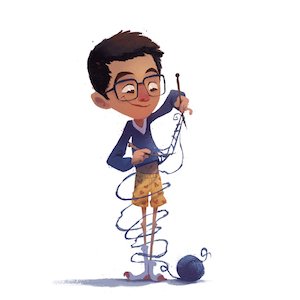Last Updated on June 25, 2022 by Laura Turner
Tell us about yourself.
I was born and raised in San Francisco, CA, went to UC Berkeley for undergrad (go Bears) and studied linguistics, then made a sharp left turn and decided to go to medical school. Now I’m a fourth year at the University of Chicago applying into pediatrics.* I’m a middle child, a West Wing fanatic, and a knitter! I like to knit (obviously), but I also like other things, like writing/reading, cooking/eating, other forms of production/consumption, and hanging out at cafes listening to music and doing crossword puzzles.
Why did you decide to go to medical school?
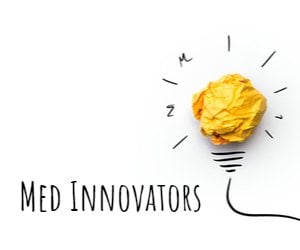 I almost didn’t! I studied linguistics and was on track to doing language documentation with dying Native American languages in Northern California, but my phonetics professor got me involved with this research project that he was doing with a neurosurgeon studying intra-operative language mapping. I spent two years analyzing language disorders and interviewing patients while they were getting brain surgery (WHILE THEY WERE GETTING BRAIN SURGERY), which was an amazing experience and unforgettable glimpse into medicine. That, in addition to the fact that I was a pretty sickly child growing up and was in and out of the hospital a lot, made medical school feel like the right move for me.
I almost didn’t! I studied linguistics and was on track to doing language documentation with dying Native American languages in Northern California, but my phonetics professor got me involved with this research project that he was doing with a neurosurgeon studying intra-operative language mapping. I spent two years analyzing language disorders and interviewing patients while they were getting brain surgery (WHILE THEY WERE GETTING BRAIN SURGERY), which was an amazing experience and unforgettable glimpse into medicine. That, in addition to the fact that I was a pretty sickly child growing up and was in and out of the hospital a lot, made medical school feel like the right move for me.
How did you get into knitting?
To impress a girl (thirteen year old me is cringing right now, but I’m just gonna push through this). In the eighth grade I had a crush on the band teacher’s daughter, and we went on a trip to Washington, DC together because we were in the same social studies class. I arranged it so I ended up sitting next to her on the bus the entire week, and the whole time I just lied my face off and pretended to be interested in everything she was interested in. (It was only kind of excruciating). At one point, she pulled out knitting needles and started to knit, so I begged her to teach me.
I haven’t said a word to her in thirteen years, but I haven’t stopped knitting since.
What do you like about knitting?
SO MANY THINGS:
1. It’s relaxing. It’s a repetitive physical movement that takes (over time) little to no brain energy. It is incredibly tactile and mindless to the point of being meditative.
2. It’s productive. I don’t like wasting time (I used to spend elementary school recess periods sorting mail in the secretary’s office…), and this is a great way for me to use my hands and constantly be creating something, even in my down time. I try to always carry a knitting project with me wherever I go, which makes waiting on long bus rides and plane trips really enjoyable. Also, Netflix binging sessions have become essentially guiltless.
3. It’s creative. While there are a million and one patterns to make essentially anything, the best part about knitting is that you can make whatever you want! If there isn’t a pattern out there for what you’re thinking about, make it up.
4. It’s useful. I live in Chicago. I need wool.
What inspired you to start knitting study aids?
It was while I was TAing the anatomy course that M1s take the first couple 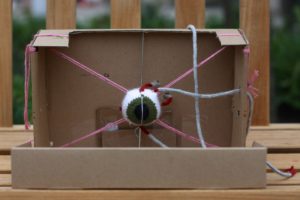 months of medical school. We were on the head & neck portion of the course, and I was preparing for Eyeball Day (very exciting day), where they learn about the eyeball and how it moves and all the muscles controlling it. I thought back to when I had learned it and remembered how frustrated I was because it was so hard to conceptualize and all the mnemonics and white board diagrams were only making me more confused. Coincidentally, I had just seen a pattern for decorative ball ornaments for Christmas trees and thought, that’s basically an eyeball! So I knitted the eye and suspended it in an old shoebox and attached ‘extra-ocular muscles’ (6 I-cords, which are just knitted cords), so that when you pulled on one or more of them, the eye would move the way it physiologically should.
months of medical school. We were on the head & neck portion of the course, and I was preparing for Eyeball Day (very exciting day), where they learn about the eyeball and how it moves and all the muscles controlling it. I thought back to when I had learned it and remembered how frustrated I was because it was so hard to conceptualize and all the mnemonics and white board diagrams were only making me more confused. Coincidentally, I had just seen a pattern for decorative ball ornaments for Christmas trees and thought, that’s basically an eyeball! So I knitted the eye and suspended it in an old shoebox and attached ‘extra-ocular muscles’ (6 I-cords, which are just knitted cords), so that when you pulled on one or more of them, the eye would move the way it physiologically should.
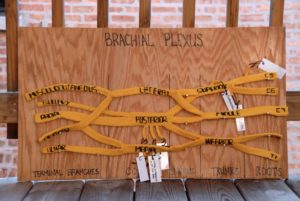 I felt like there were some parts of anatomy that could be learned better if there were some physicality to it, where you could hold and touch and manipulate it. I found this true with the eye, which relies heavily on physics, but also the brachial plexus, whose naming and branching is quite arbitrary, and abdominal viscera, which has a network of spaces and sacs that are hard to grasp with a cross-sectional illustration.
I felt like there were some parts of anatomy that could be learned better if there were some physicality to it, where you could hold and touch and manipulate it. I found this true with the eye, which relies heavily on physics, but also the brachial plexus, whose naming and branching is quite arbitrary, and abdominal viscera, which has a network of spaces and sacs that are hard to grasp with a cross-sectional illustration.
How have other students reacted to the study aids you’ve created?
Much better than I would have ever expected! I think fourteen year old me was still scared of getting ridiculed for being a guy who knits, but everyone was super enthusiastic about it and eager to get their hands on it. I think one part of it was a shared frustration that some parts of anatomy are ridiculously hard to learn, and sitting down with a study tool that you can use again and again and again until it clicks is very satisfying and something a nifty mnemonic can’t do. The other part I think is that it brought a lightness/childishness to dissection, which, when you’re doing this 9am to 5pm for ten weeks straight and you’re fresh into medical school, can be mentally draining and numbingly morbid.
Which knitted model was your favorite?
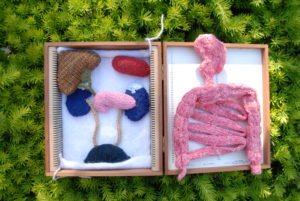 My abdominal viscera! I knit the organs of the abdomen (from the diaphragm to the dome of the bladder) and displayed them in a hollowed out, old pathology slide box. The point of the model was to demonstrate retro vs. intra-peritoneal structures as well as the connection and relations of the greater and less sac, but I included enough organs and anatomically accurate structures so that it could also be used to show normal anatomy and some pathophysiology (I put a bead into the gall bladder to represent cholelithiasis!). This was a model that I actually planned for and got specific yarn for and built in such a way to make it aesthetically pleasing. I also liked the idea of using a pathology slide box—a relic of medicine, for sure—to contain a new and modern tool for learning.
My abdominal viscera! I knit the organs of the abdomen (from the diaphragm to the dome of the bladder) and displayed them in a hollowed out, old pathology slide box. The point of the model was to demonstrate retro vs. intra-peritoneal structures as well as the connection and relations of the greater and less sac, but I included enough organs and anatomically accurate structures so that it could also be used to show normal anatomy and some pathophysiology (I put a bead into the gall bladder to represent cholelithiasis!). This was a model that I actually planned for and got specific yarn for and built in such a way to make it aesthetically pleasing. I also liked the idea of using a pathology slide box—a relic of medicine, for sure—to contain a new and modern tool for learning.
What else do you knit?
SO MANY THINGS: scarves, hats, cardigans, blankets, socks, cowls, mittens, whales, cats, ostriches, turtles. (Current project: Totoro!)
Has your knitting impacted the way you approach medicine?
I think knitting has allowed me to approach medicine with more creativity and freedom than I would have thought appropriate. Part of me had this image that medicine was a place of severe seriousness and rigor and protocols and RCTs and long white coats, but after four years of med school, I think medicine can benefit/has benefited from people just being themselves and bringing the things they love into their work, even if those things may not be obviously related. Knitting has shown me that if you love something, it’ll find a way inside you and grow you and push you, which is something I’ve been thinking about as I enter residency and consider what I want my career to look like and what things I’m going to focus on and invest myself in.
Do you have any advice for other students who are interested in learning to knit?
DO IT. For all the reasons outlined in questioned 4. But also because medical school is hard and all-consuming and we all need to take time to do things that are fun and life-giving. Don’t be discouraged if it’s not relaxing at first, or if you find you can’t watch TV and make a hat at the same time. The learning curve is steep, but it’s short. Keep at it!
Also, start with cheap yarn (your first scarf will go to your mom, who will lie to you and say she loves it and will wear it everyday), and join Ravelry.com (find me: @jedbartlet) for an endless supply of free patterns.
Anything else you want to add?
This is a shameless plug for my website: www.masculiknity.com. I put everything I knit up here. Sometimes with patterns, always with puns. I also like to write—about medicine and my own life and how if I were a woman I would want to be CJ Cregg from the West Wing—which, if you visit my site, is the reason for the huge bodies of text between portrait shots of ostriches on coffee tables.
*Daniel wrote in a blog post after the completion this interview that he matched and will be completing his pediatrics residency in Denver.
